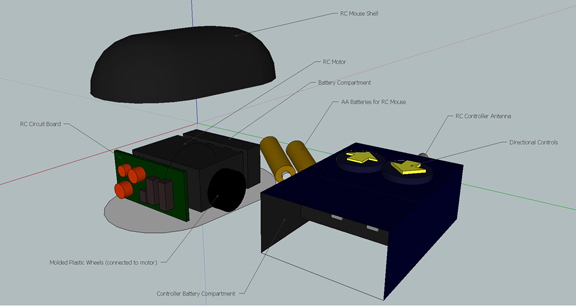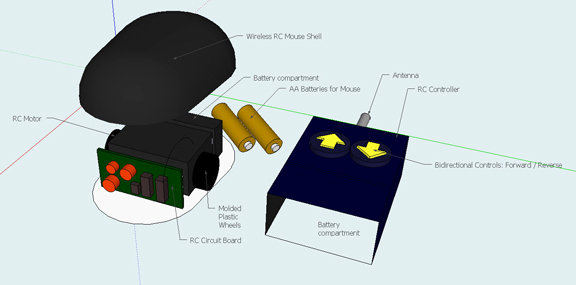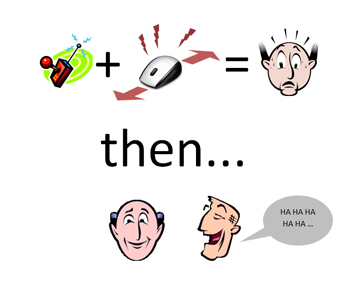Latest News
January 23, 2012
Editor’s Note: In early December 2011, DE invited readers and fans to submit their ideas for a cubicle toy. After the honorary judges have reviewed and scored more than 80 entries, three finalists emerged. Jason Cox’s remote-controlled fake mouse is one of the finalists. Here is his final entry, along with an essay in his own words explaining the evolution of his design. He hopes to get not only the judges’ votes but yours too. To vote for Jason Cox’s design, visit DE’s Facebook fan page and click Like on this image.
Jason Cox in his own words
When I approach a design challenge my first action is to answer some basic questions.
- What it the problem I’m trying to solve?
- Are there existing solutions I can utilize or expand upon, or does this problem require a conceptual design?
- What are the environmental factors to consider? That is to say, what is the budget, timeline, and are there any constraints?
Research is a major factor in answering the first two questions. Online research comes before anything else (because it’s easiest), but I may reach out to some of my network contacts in other industries. The key is not to be narrow-minded. I look for commonalities in different fields. For example: If I’m designing a crash cart for a server room, I would look at the base of office chairs, TV carts, and even portable IV stands. The crash cart needs to be mobile, so I will draw inspiration from other problems that required a mobile solution.
The third question is typically not difficult to answer as it is merely addressing the scope of the work to be completed. My Project Management background makes that question second-nature.
Once I’ve answered those questions, I move onto some simple sketching. I “whiteboard” it first (basic layout, critical path, mind-mapping, etc.). This is usually followed by a more refined approach. I’ve always used a pencil and paper for my design ideas, so I’ll start with a single sheet of copy paper. Then, if needed, I’ll move to a larger format (i.e. poster board). After I’ve finished with some initial sketches, and I’ve documented all of the critical elements, I take a break. I don’t mean I have a red bull and then get back to work. I mean a real break … for a few days. The reason for this is simple. It’s easy to be blind to flaws during the initial design phase. I must be able to recognize when I’ve designed something poorly, or when some problems exist that need to be addressed before moving forward. By taking time away, I reset my brain. When I come back to the project a couple days later, I have more of a critical perspective. I call this “the Honeymoon is over phase.” I spend one hour picking apart the design by going back to my initial questions. Did I adequately address each question? If I did, then I move on to more refining, more sketching, and expanding on my original idea. If I didn’t, then I take some time to do more research.
When I’m ready, I move onto a CAD program. In my field of work, this is more of a presentation tool than it is for tolerances or engineering analysis. I use CAD as a final design phase environment, and although I would prefer to use it more, Google SketchUp has limitations.
The last step is a postmortem to gather the “lessons learned.” It’s important for me to analyze how I handled the design as well as the final result. I make notes and file them away for future reference.
—Jason Cox
Honorary judge Tony Lockwood, DE’s editor at large, on Cox’s design: All the designs were so good that I unilaterally decided to add one more criterion to the judging guidelines. To whit: Which Cubicle Toy would Steve Robbins, DE’s Executive Editor, use to torment a co-worker’s dog? See, Robbins kept a laser pointers in his desk, armed and ready for Jack Nelson to accompany his master to work. Three, four times a day, Steve would whip the thing out then laugh hysterically as Jack bounded about the normally staid halls of DE chasing the red dot. I call this extra-judicial metric the Robbins Razz.
Jason Cox and his remote-controlled PC mouse decoy also passes the Robbins Razz. “No dog tormented here?”, you query. Right, but Robbins would execute this prank at work, at home, at a public terminals in some library, anywhere in a heart beat. And – really – who wouldn’t want to torment that special someone you work with by remorselessly controlling their computer mouse remotely? No brainer.
Honorary judge Josh Mings (SolidSmack) on Cox’s design: I can picture team-building experiments where one team tries to protect the RC Mouse and the other team tries to kick it through the office manager’s plant. All, a very valuable part of building a functional company culture.
To vote for Jason Cox’s design,visit DE’s Facebook fan page and click Like on this image.
Subscribe to our FREE magazine, FREE email newsletters or both!
Latest News
About the Author
Kenneth Wong is Digital Engineering’s resident blogger and senior editor. Email him at [email protected] or share your thoughts on this article at digitaleng.news/facebook.
Follow DE








